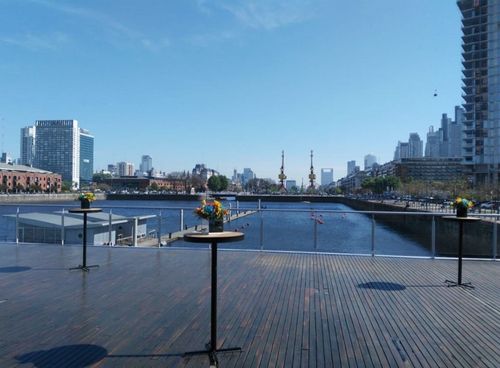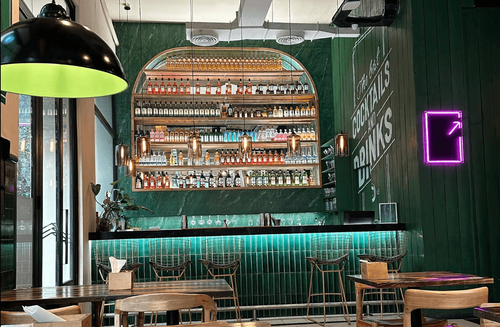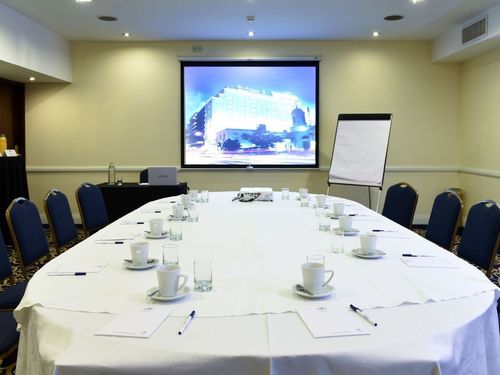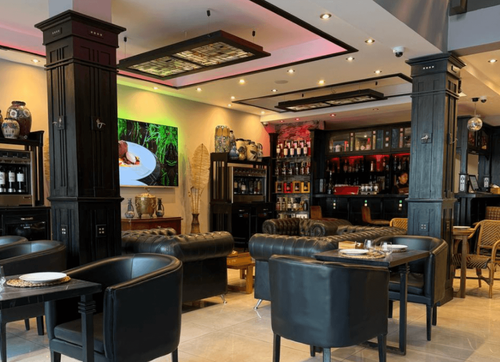Hire Meeting & Conference Rooms in Buenos Aires

Popular Meeting Rooms in Buenos Aires
Find unique meeting spaces in Buenos Aires
See AllRooftop Terrace With Historic Cathedral Views for Corporate Gatherings
This terrace in Buenos Aires is designed for corporate receptions, informal networking sessions, and private celebrations. It features direct views of an adjoining cathedral dome, a leafy courtyard atmosphere, and a rooftop setting with string lighting.It... Show More
A Unique Open-Air Setting in a Brick-Lined Industrial Street for Impactful Occasions
What if your next gathering took place in the heart of an industrial street, surrounded by towering red-brick facades and infused with urban authenticity? This one-of-a-kind setting transforms a simple passage into a striking open-air stage, where history,... Show More
Classic Meeting Hall With Patterned Wallpaper for Conferences
This elegant meeting hall in Buenos Aires combines patterned wallpaper, intricate carpeting, and framed artwork for a refined corporate backdrop. Plush seating and crisp white table linens create a polished atmosphere, while warm lighting enhances its... Show More
Industrial Rooftop Lounge With Green Wall and City Views
This rooftop lounge combines industrial edge with natural greenery and sweeping skyline views. Metallic armchairs and dark leather sofas sit against a vertical garden and dark wood flooring, framed by floor-to-ceiling glass panels. Pendant lights and a... Show More
A Luxurious Yet Cosy Setting With a Dramatic Suspended Bar for Gatherings
Imagine stepping into a world where sophistication meets warmth—where rich wooden tones and ambient lighting create an inviting yet refined atmosphere. Designed in a contemporary style with a touch of organic modernism, this setting is perfect for corporate... Show More
Open-Air Terrace Framed by Contemporary Wooden Details and Lush Greenery
Amidst the city’s vibrant streets, this open-air terrace offers a contemporary retreat where modern architecture meets natural tranquillity. Defined by sleek wooden structures and surrounded by lush greenery, it creates an inviting yet refined setting for... Show More
Refined Private Dining Room With Dramatic Lighting and Contemporary Asian Flair for High-Level Intimate Dinners
This striking private dining room is tailor-made for intimate dinners, creative workshops, cultural tastings, and high-level client meetings. Designed for groups of up to 12 guests, the space centres around a solid, rectangular wooden table that encourages... Show More
Rooftop Terrace Overlooking the River for Corporate Celebrations
Suspended above the river, this contemporary rooftop terrace combines minimalist design with panoramic city and waterfront views. Expansive wooden decking, glass railings, and geometric lines create an elegant, open-air setting ideal for business receptions,... Show More
Elegant Setting With Rustic Wooden Tables and Stylish Pendant Lighting
Step into a setting where refined architecture, lush greenery, and warm colours create an inviting atmosphere. This beautifully designed location blends classic elegance with a contemporary feel, featuring high ceilings, arched doorways, and large windows... Show More
Industrial-Style Setting with Flexible Seating for After-Work & Dining Meetings
Step into a dynamic industrial-style setting, where raw materials meet contemporary comfort to create an engaging and stylish atmosphere. This space is designed for professionals and creatives seeking an inviting yet sophisticated environment for after-work... Show More
Dragon-Infused Dining Room With Deep Red Seating for Corporate Occasions
Dominated by a dramatic sculptural dragon that coils above the dining floor, this high-concept setting offers a striking atmosphere for immersive corporate dinners, executive networking, and creative brand activations. The serpentine ceiling installation... Show More
Beaux-Arts Courtyard Terrace Framed by Ornate Architecture for Elegant Gatherings
Set within the grandeur of a historic building, this open-air courtyard terrace offers a striking backdrop for elegant receptions, networking cocktails, and evening events. Surrounded by ornate façades, French balconies, and sculptural detailing, the space... Show More
Bright Conference Hall With Lounge Foyer and Flexible Layout for Corporate Events
Ideal for focused corporate gatherings, this well-lit conference space combines contemporary style with functional design. Striped feature walls and integrated ceiling lighting create a crisp, modern atmosphere, while smooth marble flooring and sleek white... Show More
Lively Grill Restaurant with Colourful Industrial Design for Gatherings
A bold fusion of industrial charm and vibrant energy, this grill restaurant stands out with its eclectic décor and dynamic layout. The space features striking stained glass panels, exposed metal beams, and a lively colour scheme that creates a warm and... Show More
Wave-Ceiling Japanese-Inspired Dining Room for Corporate Dinners
This Japanese-inspired dining room in Buenos Aires combines sculptural architecture with refined modern design, creating an elegant setting for corporate gatherings. A dramatic timber ceiling, shaped in sweeping wave-like curves, draws the eye while dark wood... Show More
Modern Wooden Design Meets Culinary Craft in a Stunning Setting
What if your next gathering took place in a setting where design, atmosphere, and gastronomy blend seamlessly? This space radiates warmth and sophistication, effortlessly balancing business and leisure. Inspired by contemporary organic architecture, it... Show More
Luxury Dining Room with Elegant Touches, Perfect for Corporate Functions
This refined dining room offers an elegant and sophisticated setting, making it an ideal location for corporate events. The space features large windows that allow abundant natural light to flood in, creating a bright and welcoming atmosphere. With its... Show More
Art Deco–Inspired Lounge Bar for Private Dining & Receptions
Stylish lounge bar with Art Deco cues: green-marble counter, backlit fluted frontage and brass shelving under a generous skylight. Velvet chairs and walnut tables create a warm palette of mustard and slate, perfect for hosted dinners or relaxed networking.... Show More
Refined Conference Room With Adaptable Layouts for Corporate Events
This conference room in Buenos Aires offers a practical and elegant setting for professional gatherings. Neutral walls, patterned carpeting, and soft lighting provide a polished backdrop, while the layout can be customised for boardroom meetings, workshops,... Show More
Velvet Lounge With Marble Floors and Sleek Bar for Receptions
An elegant lounge featuring polished marble floors, a sleek bar with fluted detailing, and velvet chairs in rich mustard and teal tones. Walnut tables and wooden accents create warmth against the contemporary backdrop, while subtle brass finishes and soft... Show More

FAQs about Buenos Aires Meeting Rooms
The best time to host a meeting in Buenos Aires depends on what you're looking for. If you prefer mild weather and smaller crowds, spring (September to November) and autumn (March to May) are fantastic choices. These seasons offer pleasant temperatures and beautiful, blooming landscapes.
Summer (December to February) can be hot and humid, but it's also when the city comes alive with festivals and events. Winter (June to August) brings cooler weather, making it a good time for indoor meetings and exploring Buenos Aires’ cultural attractions without the summer heat.
Ultimately, the ideal time depends on your preferences and the atmosphere you want for your meeting.
Considering security aspects is essential to ensure a smooth and worry-free event. Choosing venues located in safe neighbourhoods like Puerto Madero or Recoleta provides a secure environment.
Collaborating with local security firms can add an extra layer of protection, especially for larger gatherings. When arranging transportation for attendees, opt for reputable local services and advise attendees to use registered taxis or trusted ride-sharing apps.
Providing clear communication to attendees about safe areas, emergency protocols, and contact information for local authorities enhances their confidence. Additionally, working closely with local authorities and event security experts can help you establish comprehensive safety measures, ensuring everyone's peace of mind during the meeting.
Considering language is indeed crucial for effective communication and overall attendee experience. While many people in Buenos Aires, especially in the business and tourism sectors, speak English, ensuring that your venue staff, including receptionists and event coordinators, are proficient in English to assist international attendees is essential.
Providing bilingual signage and event materials can also enhance accessibility for non-Spanish speakers. Moreover, having access to local interpreters or translation services can facilitate seamless communication, making everyone feel welcome and ensuring that your meeting's objectives are effectively conveyed to all participants.
Being language-conscious demonstrates a commitment to inclusivity and ensures that every attendee can actively engage and contribute to the discussions.
The public transportation system in Buenos Aires is fantastic! Subways - or the ‘subte’ - are the most popular way of getting around. Six lines go across the city, and it's a sweet deal at only $0.25 for a single ride!
If you think that’s cheap, wait until you hear about the bus routes. There are 336 lines to choose from, and each trip will only set you back the same $0.25.
And, as with most major cities, Buenos Aires also has a large taxi network that can help you get to your meeting (just be wary of scammers). The best way to book a taxi here is via.BA Taxi and Taxi Premium apps or by hailing a regulated black and yellow radio taxi that will charge you by the metre.



















